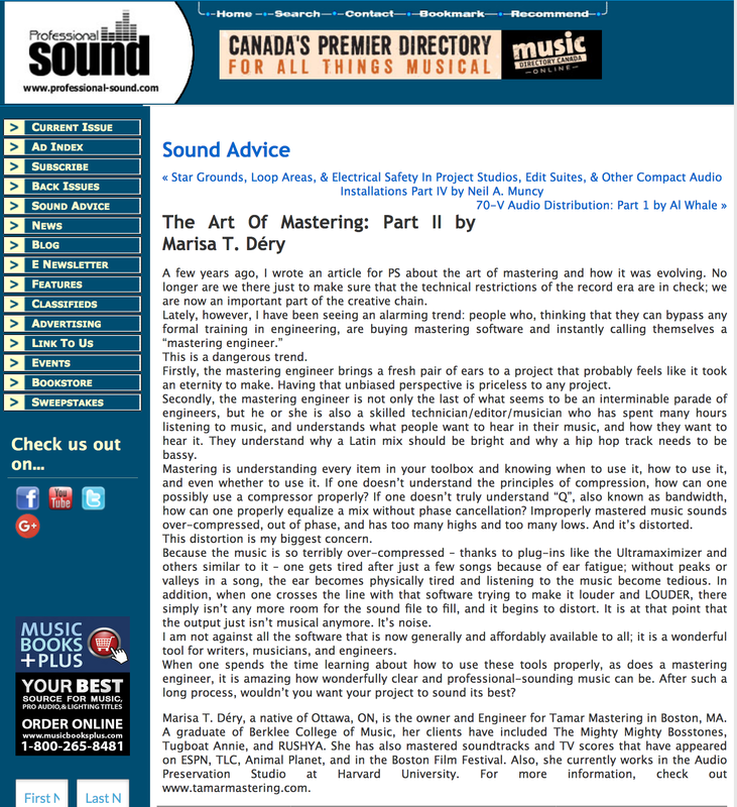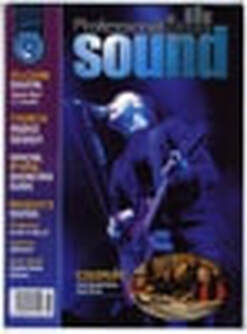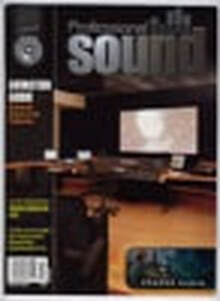Tamar Mastering-Professional Audio Mastering
Menu
|
0 Comments
by Marisa T. Déry (Published August 2003) A while ago, I was in the middle of a mix session when the engineer – looking at the clocking ticking away – said those dreaded words: “You can fix it in the mastering process” … aaahhh, memories! Just a few years ago, people were saying, “We’ll fix it in the mix.” First of all, not everything can be fixed in the mastering process. Granted, a lot can be done, but isn’t it better to use your mastering time to make things sound great and not just good enough? More than once I’ve had people hand me CD masters and an old normal bias cassette (distorted, of course) with the question: “Can you match these?” Mastering engineers do have a lot of toys and (hopefully) creativity. We will go a long way, using all means possible to make you sound as good as possible, but one also has to be realistic with one’s expectations. Clicks, crackles and pops can be removed, but if they are too long or are on top of key words, then you have problems. I’ve had old reels given to me that speed up and/or slow down randomly at various speeds; this predicament can be fixed, but it does take time. People must be aware that although we have the tools and the skills to repair problems, we still need time to do it right. We live in an instant-gratification society where people mistakenly think that if we aim the mouse on the screen and click, everything fixes itself instantly. That is not so. Regardless of the DAW or software that you have, you need time, training, expertise and instinct to do it right. A 10-minute track just might take an hour to clean up properly, so please be aware of that when setting up your budget. What Can Mastering Engineers Do? We can add bass, highs, mids; make it sound clearer and LOUDER; clean up the fade ins and the fade outs; balance the levels of the songs; put in the appropriate silence (if required) in between tracks (“if required” because I haven’t put a single second of silence in between two hip-hop songs in the last year). We can also add special effects (rain anyone?) and reverb; add post-production tracks, edit, loop, reverse, chop etc. Most mastering engineers are creative. We love music. We love sound. We would rather use our focus and energy on “the song.” We don’t just want it to sound good; we want it to sound GREAT. We get our high when the artist’s eyes light up because we were able to interpret sonically what was in his head. A master must sound as good as possible when it is given to the mastering engineer; with the right mix, a mastering engineer can concentrate entirely on the music and not worry about being a (sound) doctor. When everything is set up properly, we get that little piece of music we all know and love … those eyes are lighting up again! Marisa T. Déry, a native of Ottawa, ON, is Chief Mastering Engineer at the Tape Complex in Boston, MA and owner of Tamar Mastering. Her clients have included the Mighty Mighty Bosstones, Tugboat Annie and RUSHYA. For more info check out www.tamarmastering.com. by Marisa T. Déry (Published June 2004) Lately, I have been doing a lot of Forensic Audio – which inevitably means that I’ve been documenting all my efforts meticulously. In this field it is important to have every setting logged, and every scheme properly identified; when you are asked to be an expert witness in court, you are expected to back up your work. All this has reminded me of something that I, unfortunately, don’t often see in the music world: logging of work done on a project. When a project starts on a 4-track, gets bounced on to Pro Tools at Joe’s then uploaded at Sally’s on her Pro Tools system only to show up at a studio two months later for mixing, then the Mastering Suite 3 weeks later. Wouldn’t it be nice if all those events were logged? Too many times I get bits and pieces in the mastering suite only to be asked to “match” everything. The Audio Engineering Society is trying to improve the situation by creating the “Recommendation for delivery of recorded music projects (2003).” This concept includes a CD insert (page 28-29 – http://aes.org/technical/documents) that would be placed with the master revealing the entire history of the project. It would now be revealed that track 1 used a Waves Trueverb on the chorus or that 4 songs out of 5 are 16 bit while one is 24 bit. When each song goes through so many different engineers, it is imperative for the sake of the integrity of the project to have a record of everything. Besides, wouldn’t it be great to have all that info for the box set? Marisa T. Déry, a native of Ottawa, ON, is the owner and Mastering Engineer for Tamar Mastering in Boston, MA. A graduate of Berklee College of Music, her clients have included the Mighty Mighty Bosstones, James Day, Tugboat Annie and RUSHYA; she has also mastered soundtracks and TV scores that have appeared on ESPN, TLC, Animal Planet and the Boston Film Festival. For more info check out www.tamarmastering.com. by Marisa T. Déry (Published October 2002)
|
Marisa T. DéryArticles from Professional Sound ArchivesCategoriesCopyright © 2002-2024 Tamar Forensics LLC. All Rights Reserved
|
Site powered by Weebly. Managed by Register.ca


